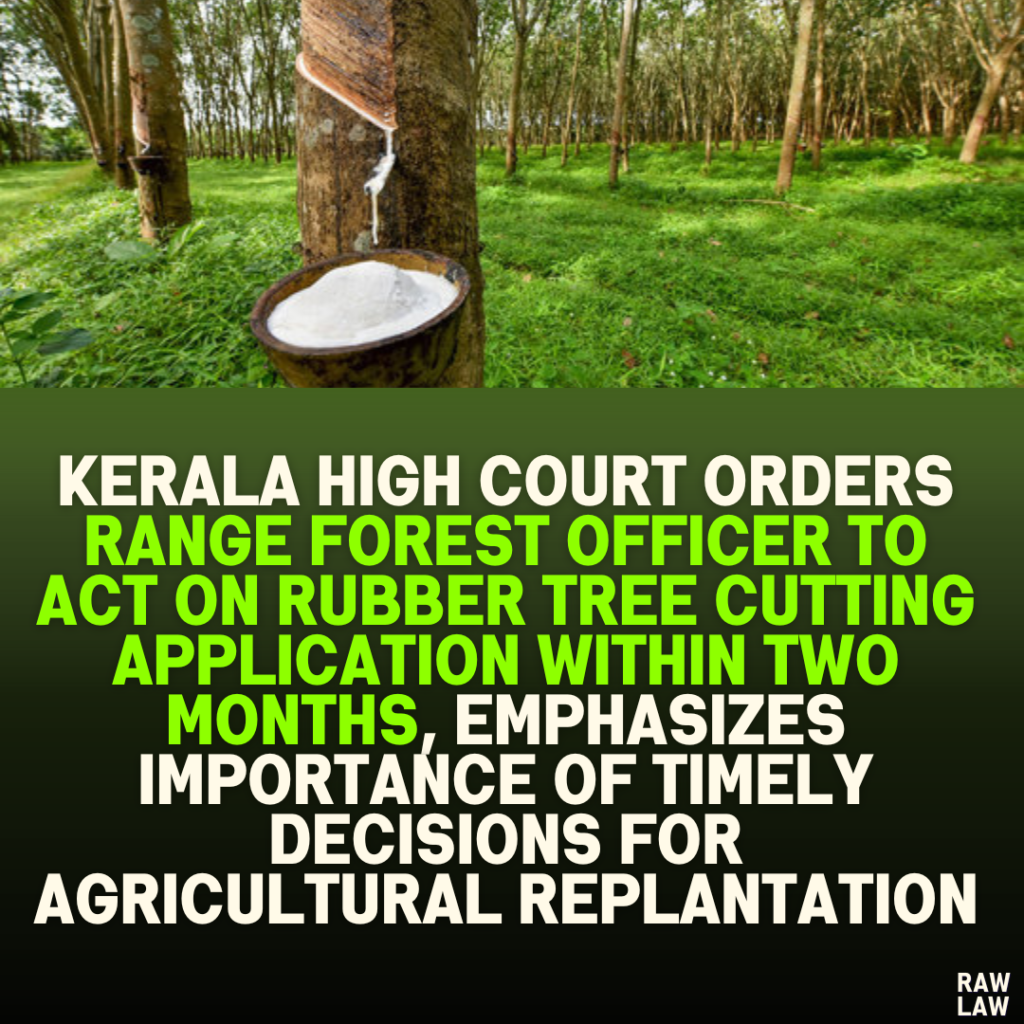Court’s Decision:
The Kerala High Court, in a writ petition (W.P.(C) No. 34022/2024), issued a direction to the fifth respondent (the Range Forest Officer) to consider and dispose of the petitioners’ application (Ext.P11) seeking permission to cut and remove rubber trees for the purpose of replantation. The Court set a deadline of two months from the receipt of the judgment for this process to be completed.
Facts:
The petitioners in this case are individuals who own land where they cultivate rubber trees. They filed an application before the fifth respondent (Range Forest Officer) requesting permission to cut and remove rubber trees for replantation. The petitioners argued that the trees needed to be removed to allow for new planting and rejuvenation of their rubber plantation. This request was not acted upon, leading the petitioners to approach the High Court.
Issues:
The core issue that the Court had to address was whether the respondent (specifically, the Range Forest Officer) should be directed to consider the petitioners’ application regarding the cutting and removal of rubber trees for replantation. The petitioners contended that their request had been pending for too long and sought a directive for its timely disposal.
Petitioner’s Arguments:
The petitioners argued that they had submitted an application to the Range Forest Officer (Ext.P11) seeking permission to cut and remove the rubber trees for the purpose of replanting. They requested that the Court issue a direction to the Range Forest Officer to consider and decide on their application without further delay. The petitioners also likely stressed the agricultural necessity of their request for replanting, emphasizing that it was crucial for the sustainability of their rubber cultivation.
Respondent’s Arguments:
While the respondents did not contest the petitioner’s request, they provided information about the procedural aspects and potential constraints on granting such permission. The respondents, including government officials such as the Range Forest Officer, did not raise a direct objection to the application but may have outlined issues relating to how and when such permissions could be given, considering the legal framework surrounding forest land management.
Analysis of the Law:
The legal analysis in this case revolved around administrative law and forest regulations. It involved the interpretation of forest-related permissions for cutting trees and the requirement for authorities to act within reasonable time limits when considering such applications. The Court’s role here was not to assess the merits of the petitioners’ request but rather to ensure that the application was given due consideration within a specified time frame.
The Court looked at the importance of ensuring that agricultural activities such as replantation could be carried out without unnecessary delays. The Court also considered the need for due process and ensuring that administrative bodies responsible for forest management follow procedural guidelines when handling such requests.
Precedent Analysis:
In this case, no specific previous judgments were cited directly by the Court. However, the Court’s ruling was influenced by general principles of administrative law, including the requirement for authorities to process applications in a timely manner, especially when they concern agricultural or economic activities such as replantation.
Court’s Reasoning:
The Court reasoned that the petitioners’ application should not be delayed indefinitely. It recognized the importance of allowing the petitioners to carry out replantation to maintain their agricultural activities. The Court thus issued a directive for the Range Forest Officer to consider the application and make a decision within two months of the receipt of the judgment.
This reasoning reflects the Court’s understanding of the balance between environmental protection (through forest regulations) and agricultural needs. While the Court did not question the substance of the petitioners’ request, it emphasized the necessity of timely consideration of such applications to avoid undue hindrances to farming activities.
Conclusion:
The High Court disposed of the writ petition by directing the Range Forest Officer to act on the petitioners’ application for tree cutting within two months. The Court did not rule on whether permission should be granted but ensured that the request would be given due consideration in a timely manner.
Implications:
The judgment has several implications, particularly in the context of agricultural practices and the regulatory framework for forest conservation. It highlights the need for prompt decision-making by government authorities when dealing with requests related to land use and forest management. This ruling stresses the importance of balancing legal compliance with the need for timely action in the agricultural sector.
The decision may also have broader implications for similar cases where farmers or landowners seek permission to carry out activities like tree cutting or replanting. The Court’s directive could be seen as encouraging a more efficient process for the consideration of such requests, ensuring that the administrative process does not hinder agricultural practices unnecessarily.
